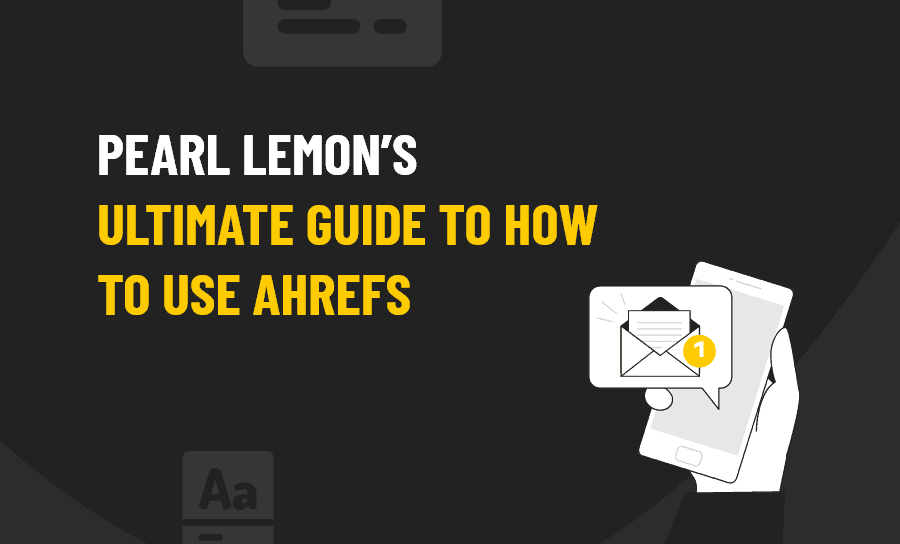As it has been around since 2011 lots of folks have heard of AHREFs, but just as many are not sure what it is or what it can do for their SEO – search engine optimization – campaigns. Or they link it’s just a backlink tool and baulk when they see the pricing, assuming that is it ridiculously high for such a tool.
But the fact is that in 2020 AHREFS has come a long way from its beginnings, which were as a simple backlink tool, and has become one of the very best tools you can have in your SEO arsenal, as we hope to show you in this guide to AHREFS.
As an agency, Pearl Lemon has been making use of AHREFS for a long time, and daily. We use it not only for gathering backlink intelligence but also for general SEO audits, content marketing ideas and analysis and even for backlink prospecting. On a personal level, many of the Pearl Lemon SEO team have been using it in their work since it first debuted.
But just what can AHREFS do, and why should you use it? That’s what we a going to take a much closer look at here.
Who is AHREFS For?
AHREFS is ideally suited to individuals and teams who will use it most days, because of the depth of information available and the features on offer so this would include:
- Digital Marketing Agencies/SEO agencies
- Teams for in-house digital marketing
- Teams for content marketing
There are other resources better suited to a smaller budget for individuals with just a casual or occasional interest in analyzing domains. However, if your SEO people use it, it’s a good sign.
When Should You Use AHREFS?
AHREFS began as a tool for analyzing backlinks, but over time, the team could use the large data set they collected to include other ways of analyzing the data. So, you can analyze your backlinks now, those of your competitors, study keyword ranking positions, perform research on keywords and conduct an analysis of your content, and even that of your rivals.
Preliminary Checks Outside AHREFS
We still do some preliminary checks and research before we jump into AHREFS for Pearl Lemon clients, and you would likely benefit from following these.
We check if the site is indexed, check whether the site is penalized, check the history of the site, and check the site’s age.
If the website is indexed, organic search results will be visible in Google’s database. For some reason, if a website is penalized, they will not, and we try to discover why Google may have taken adverse action against the site. We want to ensure that historically the site hasn’t been spammed, used as a PBN, or something else like that.
As older sites appear to react differently from younger sites, we check the age of the site. As far as link building with older sites is concerned, you can get away with a little more, and Google seems to respond a little faster when link disavowals are submitted.
The results of this research – even if we find really bad stuff like hundreds of spam links – are just the beginning of the project as everything can be changed and/or remediated. For instance, if it seems like a site has been spammed in the past, it doesn’t mean that it’s inherently due to current issues. We need to look at everything to make decisions about how to proceed.
How We Run Preliminary Website Checks for SEO Campaigns
First, we check if the site is indexed.
Go to Google and type “site:domain.com.”
Like this (using Pearl Lemon as an example)
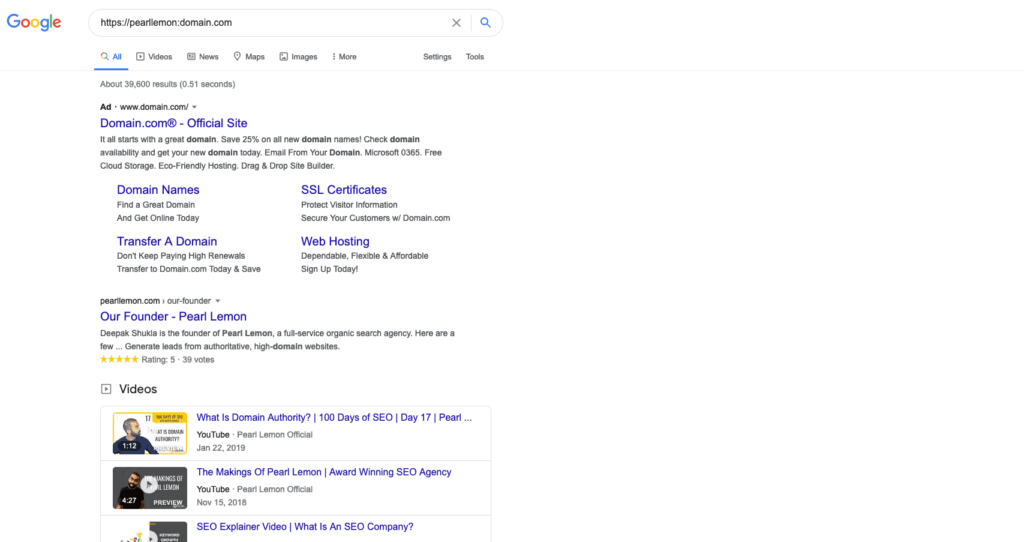
Good to know that Pearl Lemon’s site is well-indexed!
This is one example of a Google search operator, and these are pretty useful for doing a lot of things.
You want to see the site you are researching is indexed. If a website isn’t indexed, it can’t be displayed for any organic results and is a HUGE sign that there is something wrong.
If we suspect a site may have been penalized by Google, perhaps because it is not being indexed properly, the best place to check is in Google Search Console.
However, not all sites are set up on Search Console, and if that’s the case – and that will need to change – there is a trick that can give you a good idea of whether a site has been penalized (although this is the best guess.)
Input domain com. Your domain name then domain but skip the period. Like this:

As you can see, our website is showing right at the top, which is an excellent sign, all is well. If our domain had a penalty, it might not appear for a few pages.
To check the history of a site, we head to the Wayback Machine at archive.org.
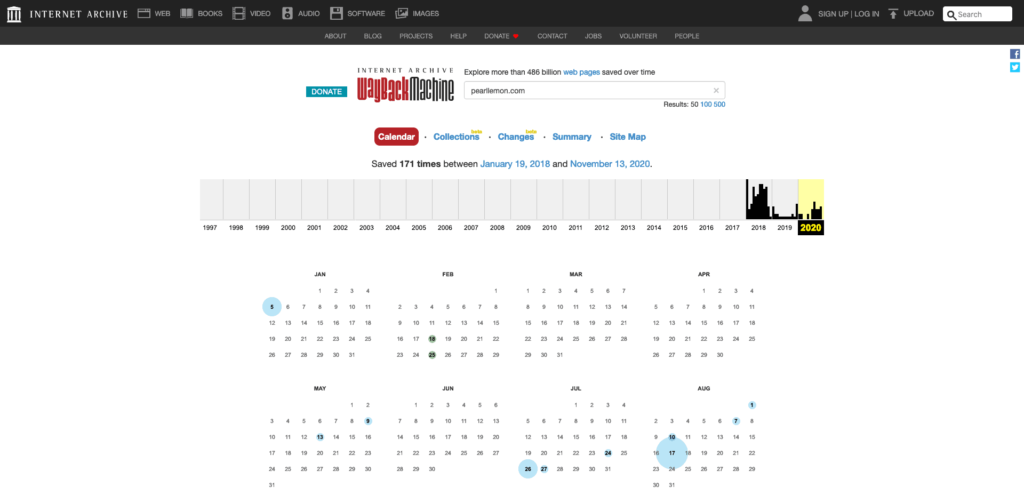
The initial screen shows us a timeline where we can look through snapshots of a website’s history. You can then click on a blue date to see a snapshot captured by the Wayback Machine of the site on that date.
A Quick Overview of AHREFS
In a hurry? Here’s a quick overview of the main features AHREFs can offer you as you pursue SEO excellence, either for your own websites or for your clients.
Perform Backlink Audits
Running a full audit of a website’s existing backlink profile is a must for any SEO campaign, and this analysis needs to be performed right at the start of the project.

AHREFs offers you a huge amount of data. This will allow you to make informed decisions about your current link profile, including your best links, any backlinks that might be hurting you (not all backlinks are good) and the areas in which you need to improve in terms of relevant backlinks.
You can also ‘spy’ on your competitor’s backlinks, which can be an excellent way to uncover new backlink opportunities for your own web properties.
Perform Keyword Research
AHREFS is not always thought of as a keyword research tool, but it’s actually a great one.

Ahrefs keywords explorer is very comprehensive, accurate, and we use it to find keywords and generate content ideas.
Track Total Organic Visibility
If you only track individual keywords as a part of your SEO campaign/reporting then, to be honest, you are way behind the times and will never get the results from your SEO campaign that you are hoping for. The most important KPI in 2020 in terms of SEO is your website’s organic traffic data, as displayed in Google Analytics.
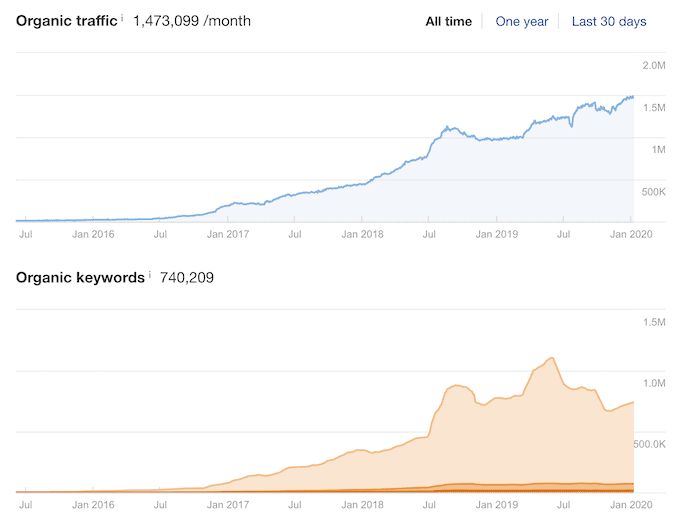
But you should make use of the functionality in AHREFS as well, as we will explain in a while.
SEO Brand Management
For keywords or branded keywords, AHREFs allows you to set up alerts to keep up to date on a real-time basis. For relationship building and brand management, this is a powerful tool.
Site Audit Tool
The site audit tool is one of the more recent additions to AHREFS, and it’s a good one too, as we’ll show you.
Understanding AHREFS Terminology
As is the case for many of the other large scale SEO tools, AHREFS uses its own terminology, and that can get a bit confusing if you don’t understand it from the outset.
AHREFS Rank
AHREFS RANK is similar to Alexa rank, something you might be more familiar with. The tool attempts to sort and rank websites based on what it estimates their search traffic volume is at any given time.

However, while it’s a useful guide, you should always take this with a grain of salt, as the tool does not have access to your internal traffic data in the way that GA does, so it should never be considered 100% accurate.
URL Rating (UR)
URL Rating is AHREFS’ metric for measuring each individual page’s authority and strength on your website. Again, there is no way it should be considered a definitive metric because it’s not, but it’s usually close enough to be very useful.
Traffic Value
Traffic Value is a metric that confuses many people, and it may not be of any real use to everyone. To calculate this number, AHREFS uses cost-per-click (CPC) data from Google Ads. For marketing professionals and salespeople trying to sell SEO services, this is a valuable metric since there is a connection between CPC and competition for search results.
In other words, if companies are prepared to pay a “high” (what is perceived to be high or low CPC is relative to the market, the business model, etc.) CPC, there is a fair probability that they are also investing heavily in SEO. The only thing is that it doesn’t guarantee better results by pouring more cash into SEO, which is perhaps a selling point for organic SEO; you can leverage with prospective clients.
How to Do a Backlink Audit in AHREFS
There are many ways and lots of tools, available to discover what backlinks are feeding into your website. However, as we are looking at AHREFS, it’s their dashboard and processes we will refer to.
Getting started is easy enough:
- If you don’t have an AHREFs account and are unsure that you would ever need one you can sign up for a week’s trial for $7.
- Begin by inputting your domain into the search box.
- Hit “Backlinks” Select “All links” in the options

Even with a free trial account, you will get a lot of results (hopefully). But getting excited because you see a lot of links is premature. The idea behind a backlink audit is that you discover the value of the backlinks you have, and not all of them are going to be links you actually want.
For example, this relatively new website seems to have an awful lot of backlinks. At first glance, it would seem great for a new site (under two years old) like this one.

However, the site’s DR is very low. This would indicate that there may be something wrong with some of these backlinks, so the real work begins.
As you can see in the left-hand dashboard, there are many data sets available that should help us do this. The great thing about an AHREFS membership is that you can drill down as much, or as little as you’d like.
If you click on that backlinks number – 13.4K in this case – you’ll get a slew of data, like this:
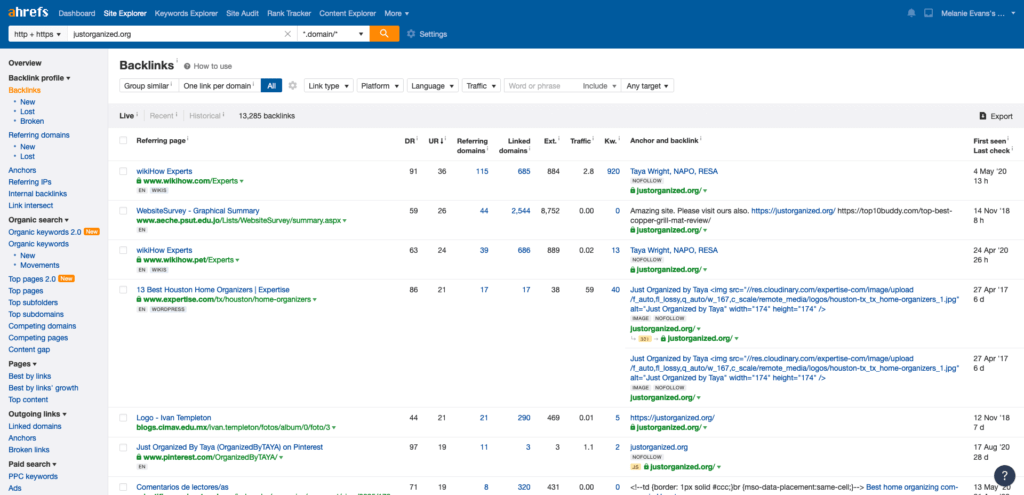
And it can be confusing. There are, for example, some great backlinks here, some so-so links, and then, as you move through, some not so great ones. There are also links of very different ages.
This is where the serious backlink analysis stuff begins. For example, although these links come from a decent UR site, its DR is poor. And it is in a different language and based in Europe, which is odd for a service business based in Houston, TX. Google almost certainly agree on that.
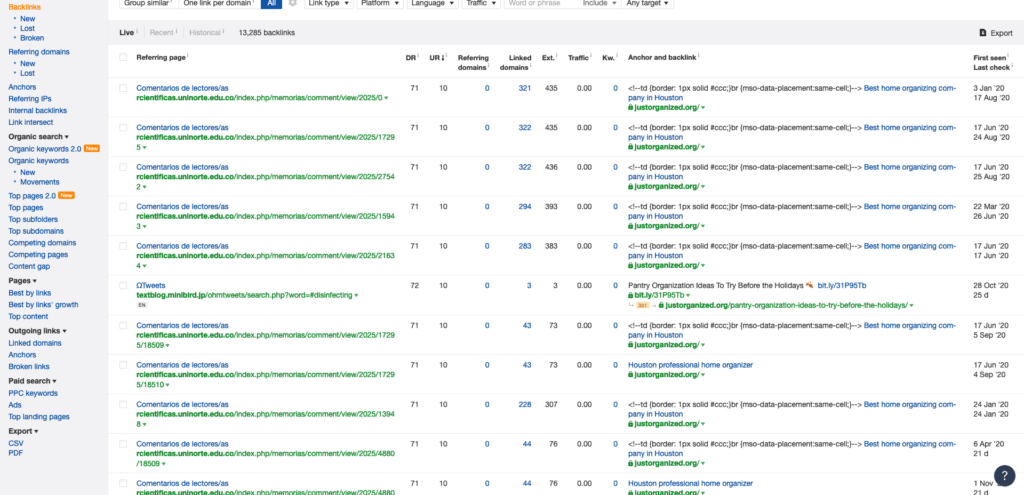
It will be up to someone analyzing these links to figure out if these links damage the site, how they got there, why they are there and if they are worth keeping. That’s the thing. AHREFs is a great tool, but, fair warning, to use it, you’ll need the knowledge of backlink best practices for it to be helpful.
However, there are some basics you can look at to better determine how much help you might need if you are not an SEO person with a lot of knowledge about backlinks. For example, on that question about how bad/good all of those thousands of links are.
Here, in the Referring Domains section, you can get a clear snapshot of the referring sites’ general reputations. Just on the first page in this example, some excellent ones, and some pretty bad ones.
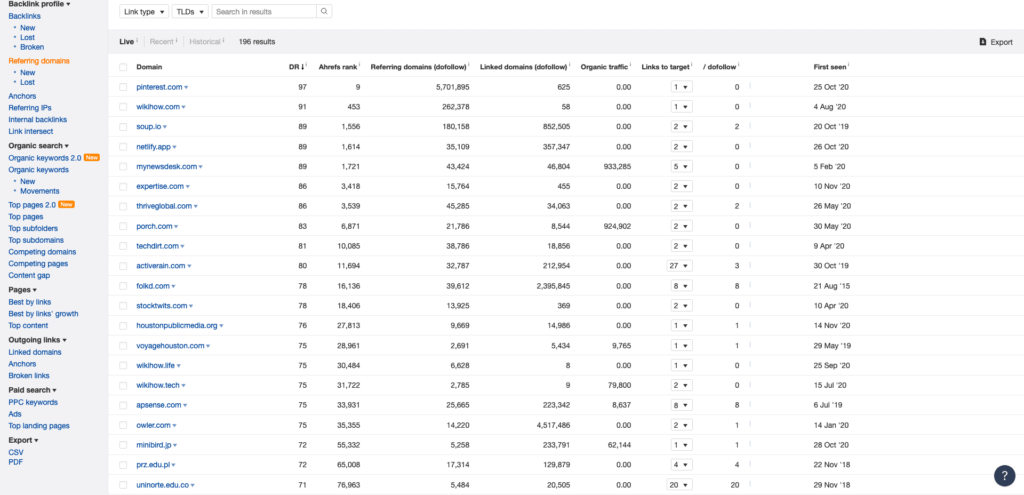
From an SEO point of view, the one thing that can be stated with certainty is that this link profile needs a lot of work.
Google sees backlinks as a vote of confidence in the content. So, a link from a respected site like Wikihow is excellent. Many of these other sites on the list, not so much, especially when you go deeper into the report.
Looking at New links can help if you have a site, like this one, that may have done some dodgy things with backlinks in the past. Sadly, it looks like this website still is, despite having earned, in the past, some great links that cannot be bought.
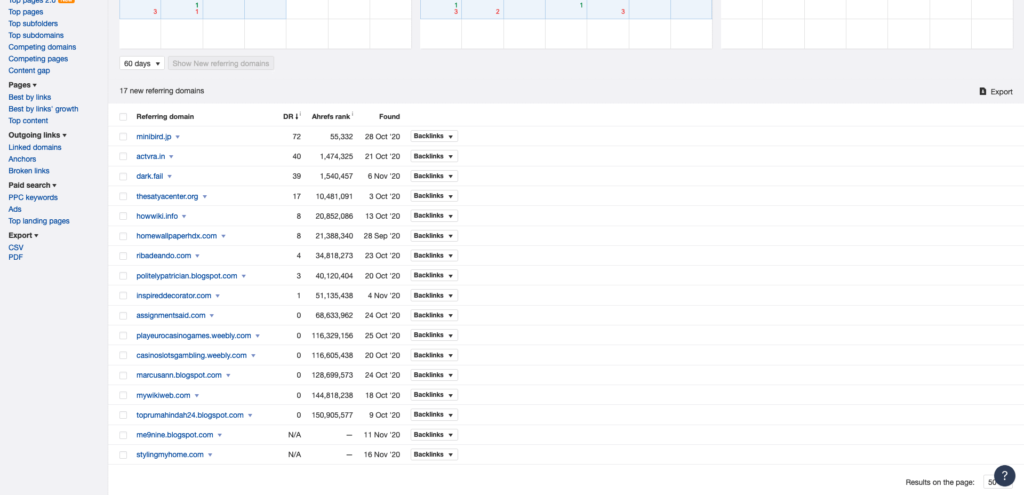
To perform a backlink audit on a site with problems, like this one, is where AHREFS often scores over simply using Google tools, and even over some other popular backlink tools. There is a LOT of information available, and it may all be beneficial if you have the knowledge to use it.
How to Do Keyword Research With AHREFS
If the backlink research in AHREFs can get very complicated and call for an amateur to get help from the pros, keyword research in the tool is a little more user friendly.
As we mentioned, as a keyword research tool, AHREFS is seriously underrated. It can be easier to use as a newbie. And produce more accurate results if you follow the right steps:
Analyze Competitors URLs in AHREFS Site Explorer
You should not start by analyzing your own site’s existing keywords, or even the keywords you think might be good for your site and your brand. Instead, you should get started by analyzing at least one of your main competitor’s URLs.

If you have a full AHREFs membership, then you’ll be given a TON of keywords to work with. You can make a note of them separately in a shared workspace, download them into an Excel sheet, scribble them on a napkin, save them to your dashboard or whatever works for you. Then move onto the next step.
Go to Organic Keywords
Next, you’ll want to navigate to “Organic keywords” under the “Organic search” section of the analysis you are running.

Here you are likely to find a veritable GOLDMINE of keyword ideas, but to get the most out of this feature – and not drive yourself nuts – you’ll need to filter the results down into more manageable data sets.
Using the filters is where the real SEO keyword magic happens, but you need to determine one thing before you begin:
In reality, what is your website going to be able to rank for?
In other words, do you have a good grasp of the real strength of your website?
The reason you need to do this – and do it realistically – is that the authority of your site will decide what keywords you should target to be successful in ranking for them.
For example, if you have a brand-new website, you need to target long-tail keywords with less competition. You can’t run before you walk. You can only realistically target more competitive keywords if you have an authoritative website relative to the competition you are analyzing. If your ‘clout’ is not significantly better than theirs, then you will be spinning your wheels.
However, search has changed A LOT, and long-tail keywords can significantly outperform shorter ones when utilized in a good, focused SEO campaign.
We are going to assume that you have a new website for this example. The first step is to filter your results on the basis of one of the most significant SEO metrics, the “Volume” keyword, or in other words, the average monthly search volume.

Targeting keywords found in the 100 – 1,000 search volume range is a good idea for new websites. Here the keyword rankings will be less competitive and longer tail, exactly what you should be looking for.
Don’t think that you should stay in this target range; you should make it a goal to step up into higher search volume ranges as your website starts to gain authority.
The ‘Words’ filter is helpful too. If you only want to see long-tail keywords, then you should set the character limit in the right place in the keyword data field.

At this point, you will have seriously narrowed your results, and you could quit and use what you’ve discovered to get your campaign started. Or, you could follow an extra step – we do – and use the position filter as well.
This will let you see where your competitor is ranking for each keyword in your set.

This is important data for several reasons:
- There’s a fair chance that your competition does not target a particular keyword term. For those long-tail keywords, the competitor probably shows up only because of their page authority. Not that they are targeting them directly.
- The rating of several long tails on the second or even third page would be loosely relevant to the primary keywords your competitors are ranking for. That gives you a chance to step in and conquer that targeted long-tail keyword.
Make Sure to Monitor Your Competitor’s “New” Keywords

On an ongoing basis, you should keep checking on your competitor’s new keywords. You can do this by clicking on “New” under the “Organic keywords” section.
So, you might be wondering why you should care about your competitor’s “new” keywords?
The first reason is that you don’t want them to gain too much momentum. You don’t want them to get too far ahead of you.
As the collateral they are using to rank – the content pages and blog posts, guest posts etc. – will naturally gain more visibility, leading to more backlinks, social signals and other user signals. These signals will not only help your competitor rank even higher but will also solidify their position ahead of you.
Once you find these new keywords, it’s up to you – or your SEO team – to make a concentrated effort to figure out the best way to compete with them – and hopefully leapfrog over them – in searches for those keywords.
Monitor Your Competiton’s Best Pages Too
You should not just keep an eye on your competitor’s blog posts etc. But also look at their website’s best-performing pages in general, to see if you can one-up them there too. You can do this by navigating to the top pages section in the organic search view in the AHREFS dashboard.
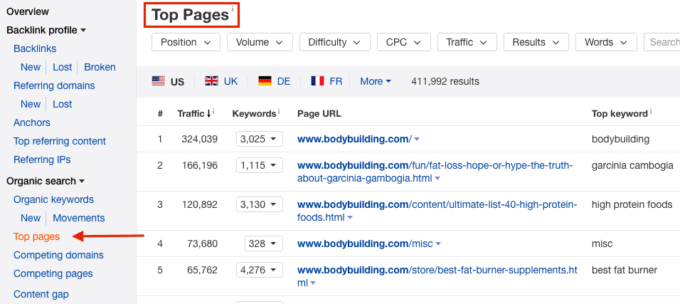
This is especially helpful for content ideation as these are topics that have already been validated as of interest or value to your target audience. This means that spending time in this section will help you create SEO focused content that also offers your audience the kind of useful stuff they are hungry for.
You will also find out just what type of content you should be creating to meet what Google is determining will fulfil searcher intent which is hugely important for SERPs placement.
Find Your Content Gaps
Where are your content gaps? What could you add to your content strategy that would really help you jump ahead of your competitors? You can use AHREFS Content Gap Tool to find out.
Click on “Content gap” under the “Organic search” section.
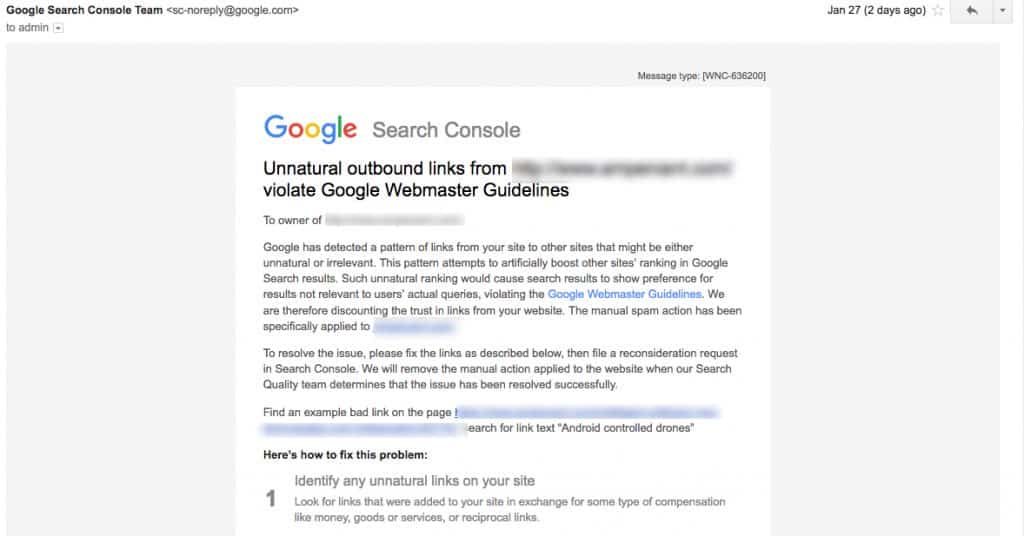
Here you will see just what keywords your website is not ranking for are NOT ranking for, but your competitors ARE. You can add more than one, but we’ll stick to a single rival for this example.

Does this sound a bit like war by the way? Truth is it really is. But back to the matter at hand…
Input your URL into the “But the following target doesn’t rank for” section and click “Show keywords”.

You’ll see keywords and content ideas that you aren’t currently targeting.

For these search terms, it’s your job to compete. That means you need to build pages for these keywords that are far more useful (and different) than your competitors.
More Stuff You Can Do in AHREFS
You will find new opportunities to create backlinks with Ahrefs’ Link Intersect marketing tool. It’s one of the comparisons features of the link profile that shows sites that link to the web pages of your competitors but don’t link to you. Through a detailed keyword performance report and its search volumes, you can estimate traffic potential and add this opportunity to your link building strategies.
AHREFS Content Explorer is another great SEO tool for doing keyword analysis. It helps you find suggestions for keywords for new content development. It also provides you with useful competition analysis to find new seed keywords and subject topics for your website blog (you do have a blog right???) This great video walks you through making the most of this advanced feature
How Much Does AHREFS Cost?
Ah, the big question. Warning, if you are looking for a cheap SEO tool, this isn’t it. But that’s also true of other tools like SEM Rush and MOZ.
Here’s the pricing table as it stands at the time of writing:
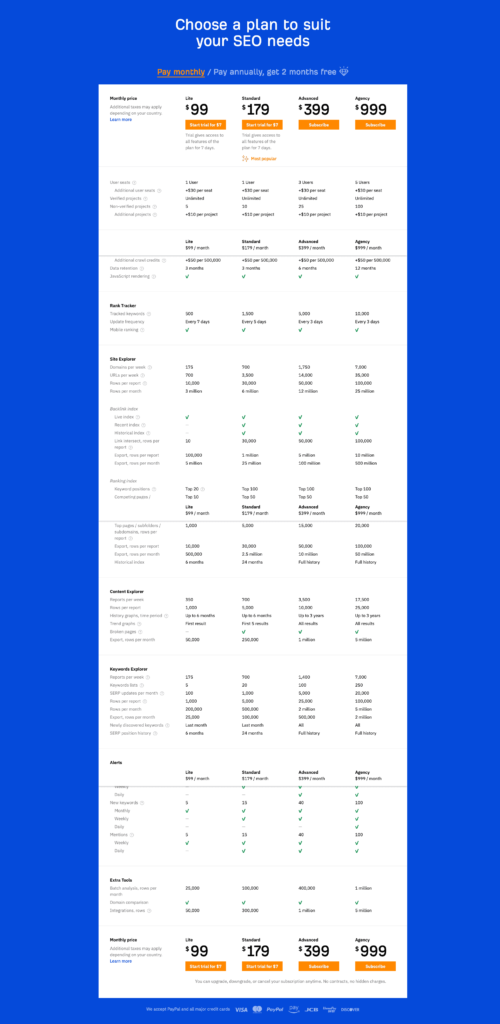
You can head here if you want to go through all those small print details. The Lite Plan is probably enough for a single website, by the way, so given that AHREFS can replace a lot of other little tools – little tools that may come with their own ‘little’ fees – you may not find that the pricing is that bad after all.
Is AHREFS The Right Tool For You?
As we mentioned right at the start, AHREFS is not the only option you have for the kinds of functionality it offers. While there are more choices, it’s fair to say that in 2020 the choice usually comes down to AHREFS or SEM Rush. You can, however, use both. We do.
There is a lot of crossover between the two tools. And the pricing is fairly similar. From the perspective of an SEO agency, having a basic subscription to both (at least) is probably well worth considering. For a small scale project – a single website being audited and optimized by someone not so familiar with SEO, AHREFS may be the better choice. That’s because (in our opinion anyway)
AHREFS has a cleaner, clearer interface that is easier to understand.
Keyword searches in AHREFS are simpler.
If you want to get more keywords for search engines like Amazon, Bing, Yahoo, Yandex,
Daum, Naver, Seznam etc. then AHREFS has more to offer.
The fact is though you really can’t go wrong with either AHREFS or SEMrush. They are both excellent tools (and a guide to SEMRush is coming very soon), and you’ll get a lot – and learn a lot – from them both.

